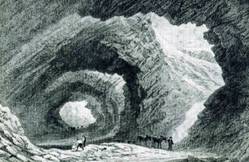
Ambitious multi-million pound plans for a world class visitor and education centre to be created in Dudley have taken a step closer to becoming a reality, writes Adler deWind
Geoscientist Online 30 September 2008
The Heritage Lottery Fund (HLF) has awarded a grant of nearly £800,000 to Dudley Council to enhance Wren’s Nest National Nature Reserve (NNR) for its project, Ripples Through Time.
The plans include providing access to the well known Seven Sisters limestone mine entrance. There will also be a focus on providing enhanced access, education and interpretation of the National Nature Reserve as well as developing opportunities for training and volunteering.
As a site of Special Scientific Interest (SSSI) and a Scheduled Ancient Monument (SAM), council bosses are delighted with the successful bid. It will ensure the vision for Wren’s Nest becomes a reality, despite having missed out on the televised People’s Millions £50 million lottery jackpot last December.
The successful Stage 1 Pass of £711,000 and development grant of £88,500 highlights the authority’s desire to push ahead with the Strata vision, which will now see Wren’s Nest become a world class destination for geology and environmental regeneration. The cost to realise these first stage plans are just over £1.1 million, with the council and other partners funding the remainder of the project.
The physical developments to the national nature reserve will include improvements to entrances, paths, steps and fencing and the creation of a new accessible route around the reserve. In addition, the project will renew external access to the principal scheduled ancient monument feature of the nature reserve, the Seven Sisters mine. The caverns have been fenced off and inaccessible to the public for the last seven years.
Through the plans, visitors will be able to interpret and learn about the site and how 420 million years of geology led to the Black Country becoming the ‘workshop of the world’. This will be done through integrated, site-wide interpretation of the nature reserve and its features, including the Seven Sisters through art installations, lighting and sculpture. Current visitor levels number some 12,000 per year, and it is hoped that these improvements will see this rise to at least 20,000.
Learning resources including on-site and outreach programmes, website development, downloadable learning packages such as podcasts and expanded guided walks, talks and special events will also be provided.
Meanwhile a learning and community development officer will be employed to encourage volunteer development and help establish a community partnership group. The officer will also encourage involvement of local young people in the development of the proposals.
Councillor David Caunt, leader of the council, said: “We are absolutely delighted to have received this funding to get the project up and running. We were of course disappointed to miss out on the funding last year but this shows our intent for the Wren’s Nest project and we look forward to seeing these plans become a reality.
"We are confident that this initial development will help to realise the diverse potential of Wren's Nest for natural and cultural heritage and conserve its features of international, national and local importance for future generations."
Anne Jenkins, head of Heritage Lottery Fund for the West Midlands, said: “Wren’s Nest is a geological jewel in Dudley and we are very pleased to support this project. We look forward to seeing further developed plans next year and ultimately the benefits that this work will bring to visitors and the local community alike.”
Council regeneration officers will now work with the HLF to produce detailed designs with additional community consultation being undertaken early next year. Work could then begin on the scheme in Winter 2009 and all the site access improvements completed during 2011.
Meanwhile Dudley Council continues to seek additional funding to stabilise the caverns before re-opening them as a visitor attraction.
Wren’s Nest NNR is a classic geological site, world famous for its large numbers of beautifully preserved middle Silurian (Wenlock) fossils. The rocks are largely limestone and shales deposited between 439 and 409 million years ago. Trilobites are Wren’s Nest’s National Nature Reserves best known fossils, the most famous being Calymene blumenbachi, commonly referred to as the ‘Dudley bug’.
Its designations have been in recognition of the exceptional international importance of the site as a source of fossils in Silurian limestone (NNR) and because it is a nationally impressive preserved whole industrial landscape of the Limestone Industry. The industrial remains on the site represent every stage in the eventual production of lime, back through its burning in the kiln, its transportation from its point of extraction, and into the quarries and mines themselves (SAM). The National Nature Reserve is considered by geologists to be Natural England’s ‘jewel in the crown’ of the SSSI series.
The Seven Sisters Mine (Upper Gallery) is thought to be the last remaining surface limestone mine of its kind left in Europe and possibly the world, making it a unique and internationally important heritage feature.